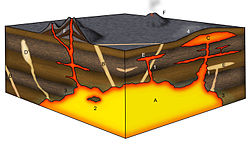
Back Rotssiklus Afrikaans دورة صخرية Arabic Скален цикъл Bulgarian चट्टान चक्र Bihari Litogènesi Catalan Kreislauf der Gesteine German Cirkulado de la rokaĵoj Esperanto Ciclo litológico Spanish Kivimite ringe Estonian Litogenesi Basque
This article includes a list of general references, but it lacks sufficient corresponding inline citations. (January 2014) |



The rock cycle is a basic concept in geology that describes transitions through geologic time among the three main rock types: sedimentary, metamorphic, and igneous. Each rock type is altered when it is forced out of its equilibrium conditions. For example, an igneous rock such as basalt may break down and dissolve when exposed to the atmosphere, or melt as it is subducted under a continent. Due to the driving forces of the rock cycle, plate tectonics and the water cycle, rocks do not remain in equilibrium and change as they encounter new environments. The rock cycle explains how the three rock types are related to each other, and how processes change from one type to another over time. This cyclical aspect makes rock change a geologic cycle and, on planets containing life, a biogeochemical cycle.

- ^ "The Rock Cycle". National Geographic. Education National Geographic. Retrieved 8 May 2023.